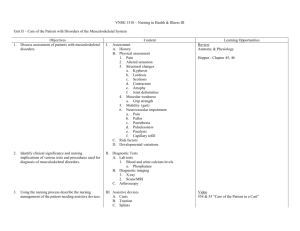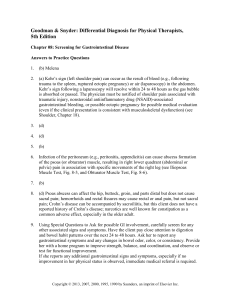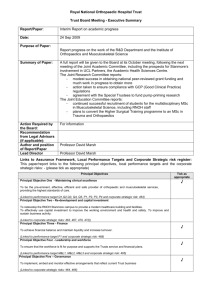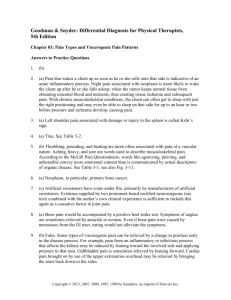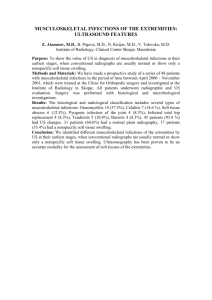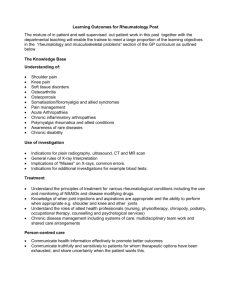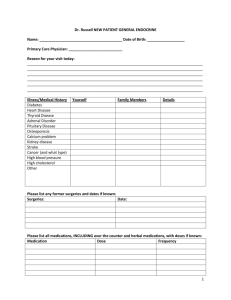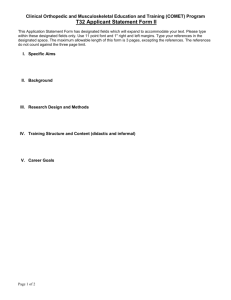Musculoskeletal-related absenteeism among nursing staff in Greek
advertisement
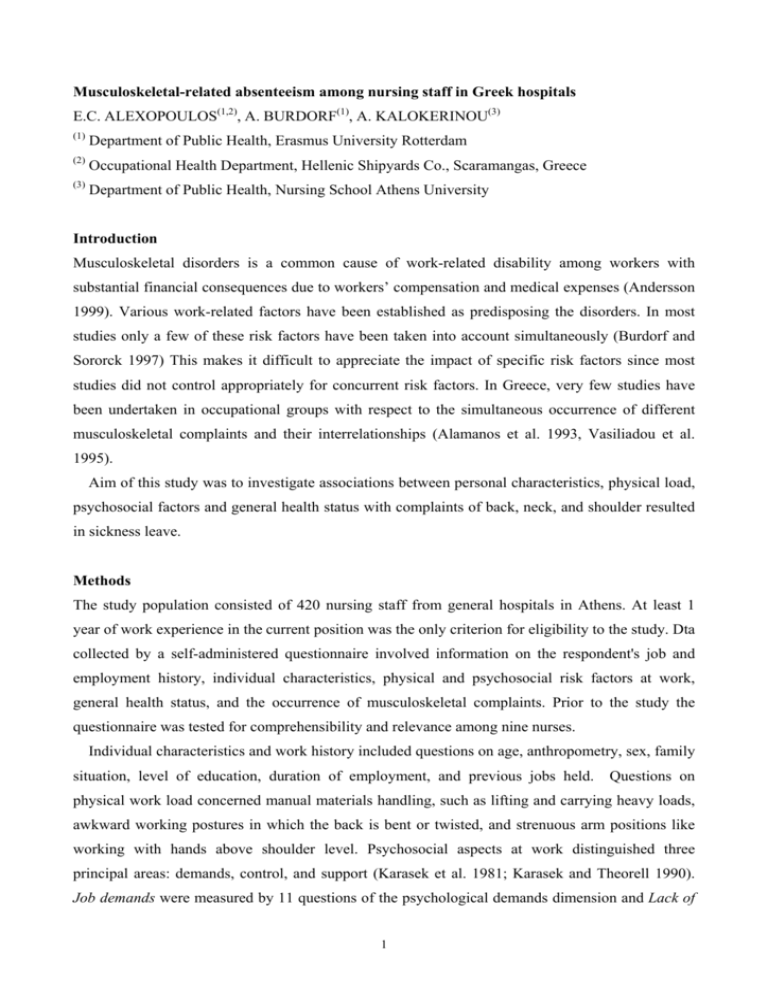
Musculoskeletal-related absenteeism among nursing staff in Greek hospitals E.C. ALEXOPOULOS(1,2), A. BURDORF(1), A. KALOKERINOU(3) (1) Department of Public Health, Erasmus University Rotterdam (2) Occupational Health Department, Hellenic Shipyards Co., Scaramangas, Greece (3) Department of Public Health, Nursing School Athens University Introduction Musculoskeletal disorders is a common cause of work-related disability among workers with substantial financial consequences due to workers’ compensation and medical expenses (Andersson 1999). Various work-related factors have been established as predisposing the disorders. In most studies only a few of these risk factors have been taken into account simultaneously (Burdorf and Sororck 1997) This makes it difficult to appreciate the impact of specific risk factors since most studies did not control appropriately for concurrent risk factors. In Greece, very few studies have been undertaken in occupational groups with respect to the simultaneous occurrence of different musculoskeletal complaints and their interrelationships (Alamanos et al. 1993, Vasiliadou et al. 1995). Aim of this study was to investigate associations between personal characteristics, physical load, psychosocial factors and general health status with complaints of back, neck, and shoulder resulted in sickness leave. Methods The study population consisted of 420 nursing staff from general hospitals in Athens. At least 1 year of work experience in the current position was the only criterion for eligibility to the study. Dta collected by a self-administered questionnaire involved information on the respondent's job and employment history, individual characteristics, physical and psychosocial risk factors at work, general health status, and the occurrence of musculoskeletal complaints. Prior to the study the questionnaire was tested for comprehensibility and relevance among nine nurses. Individual characteristics and work history included questions on age, anthropometry, sex, family situation, level of education, duration of employment, and previous jobs held. Questions on physical work load concerned manual materials handling, such as lifting and carrying heavy loads, awkward working postures in which the back is bent or twisted, and strenuous arm positions like working with hands above shoulder level. Psychosocial aspects at work distinguished three principal areas: demands, control, and support (Karasek et al. 1981; Karasek and Theorell 1990). Job demands were measured by 11 questions of the psychological demands dimension and Lack of 1 control (decision latitude) was measured by 17 questions of the Decision Latitude dimension both from the Demand/Control model from Karasek (Karasek et al. 1998). Lack of co-worker support and Lack of supervisor support was measured by 18 questions (Karasek et al. 1998). In the statistical analysis, scores above the median value considered as the presence of psychosocial risk. The health status of each subject was ascertained with three different outcomes, i.e. perceived general health, need for recovery, and musculoskeletal complaints. Perceived general health status was ascertained by 13 dichotomized questions about subjective health complaints, such as respiratory complaints, stomach complaints, regular headache, and tiredness. A sum score was calculated to represent the worker's actual health situation. Need for recovery was measured with 11 dichotomized questions to assess short-term health effects that reflect the worker's need for recovery at the end of a regular workday. These questions addressed items such as tiredness after work, fatigue, lack of concentration, putting interest in other people, the ability to recover from work, and the influence on work performance (Sluiter et al. 1999). For both general health endpoints subjects with a score above the median value were considered to have a high need for recovery or a moderate/bad general health. Musculoskeletal complaints were measured using the standardized Nordic questionnaire (Kuorinka et al. 1987). The endpoint was musculoskeletal complaint of back, neck, or shoulder defined as pain in the past 12 months, which had continued for at least a few hours during the past 12 months and which led to a period of sickness absence in the past 12 months. Logistic regression analysis was performed to evaluate the influence of individual characteristics, physical and psychosocial risk factors at work, and health status on the occurrence of sickness absence due to musculoskeletal complaints. Prevalence odds ratios (PORs) with 95% confidence intervals (95% CI) were calculated as measure of association, adjusted for age and sex. Data analyses were conducted by means of the SPSS for Windows 10.1.0 statistical package (SPSS 1999). Results The initial response to participate in the study was 90% (377 / 420 respondents). The principal reasons for non-participation were: holiday or maternity leave, changing shifts, and refusals. In total, 26 questionnaires (7%) which had insufficient data on musculoskeletal complaints or respondents who failed to return the questionnaire in due time (two weeks) were excluded from the study. The total study population consisted of 351 persons (response 84%). Table 1 shows basic characteristics of the study population. The subjects consisted predominantly of women (81%), with age ranging from 23 to 61 years. The main proportion consisted of highly 2 educated nurses with 60% having more than three years of higher vocational education and significantly more years in the current job than men, 13.0 and 11.3 respectively. Frequent lifting of materials over 5 kg was often or always part of the job reported 64% of the nurses. Pushing and pulling of loads over 50 kg and carrying of loads over 25 kg was highly associated with frequent lifting. Strenuous shoulder movements, primarily repetitive movements, were reported by 46% and awkward back posture, primarily flexion of the back, was reported by 50%. High job demands and low job control seemed more important psychosocial risk factors than lack of a supportive work environment. The self-reported risk factors were partly determined by personal characteristics. None of the psychosocial factors did show a significant trend for either age or duration of employment (Alexopoulos et al. 2003). Table 2 presents the 12-month prevalences of complaints and absenteeism. Low-back pain was the most prevalent musculoskeletal complaint, reported by 75% of the subjects. Neck and shoulder pain resulted significantly less in a spell of sickness absence than back pain. From those reported a complaint, 22.3% took a sick leave for back, 10.9% for neck and, 13% for shoulder pain. It was observed that the probability of a period of sickness absence due to neck or shoulder complaints was significantly increased when also a sickness absence period for back complaints had occurred in the past year. Table 1 Personal characteristics and working experience among nursing personnel (n=351) in six Greek hospitals Men Women (n=67) (n=284) Age (y, mean (SD)) 37.4 (7.4) 37.0 (7.2) Height (cm, mean(SD)) 176.9 (7.9) 163.9 (5.8) 26.5 (3.1) 23.8 (4.2) Higher 55 61 Lower 45 39 11.2 (5.6) 13.0 (7.2) Body mass index (kg/m2, mean (SD)) Educational level (%) Duration of employment (y, mean (SD)) 3 Table 2 Prevalence of musculoskeletal complaints of back, neck, and shoulder in the past 12 months among nursing personnel (n=351) in Greek hospitals Neck n % Shoulders Low back n n % Occurrence in the past 12 months 165 47 131 37 264 Complaints with sickness absence 18 5 17 5 59 % 75 17 Univariate analyses and results of the multivariate analyses on risk factors for the occurrence of back, shoulder and neck complaints have been presented elsewhere (Alexopoulos et al. 2003). All risk factors were dichotomized before being entered into the logistic models. All self-reported physical risk factors were significantly related to the occurrence of low back, shoulder, and neck pain. In addition, none of physical factors was associated with sickness absence due to musculoskeletal complaints. Low job control was significant risk factor for sickness absence due to back pain or neck pain. It is worth noting that in univariate analysis high BMI was also significant for absenteeism due to back and shoulder pain. High need for recovery at the end of the workday and especially a perceived moderate/bad general health were significantly associated with most musculoskeletal complaints and sickness absence. Table 3 Multivariate analysis of risk factors and absenteeism due to musculoskeletal pain in the past 12 months among nursing personnel (n=351) in Greek hospitals Self reported factors risk Low back pain with sick Shoulder pain with Neck pain with leave sick leave Sick leave OR (95% CI) OR (95% CI) OR (95% CI) < 35 1.00 1.00 1.00 35 – 40 1.54 (0.68 to 3.48) 2.00 (0.35 to 11.55) 0.78 (0.20 to 3.06) 40 > 4.50 (2.12 to 9.55) 10.57 (2.18 to 51.22) 2.94 (0.91 to 9.51) Age Sex Male 1.00 Female Low job control Moderate NS 0.15 (0.04 to 0.53) NS NS NS 3.87 (1.20 to 12.41) 6.84 (1.75 to 26.74) 8.31 (1.85 to 37.21) perceived 2.03 (1.09 to 3.77) general health OR = prevalence ratio; 95% CI = 95% confidence interval. 4 In multivariate analysis (table 3) on risk factors for sickness absence showed different results from the analysis on musculoskeletal complaints in the past 12 months. For all complaints sickness absence increased with age with odds ratios for those of 40 years or older varying from 2.94 to 10.57. Perceived moderate/bad health was the single most important risk factor for sickness absence due to back pain (OR=2.03; 95 CI% 1.09-3.77), neck pain (OR=8.31; 95 CI% 1.85-37.21), and shoulder pain (OR=6.84; 95 CI% 1.75-26.74). Sex was highly related to shoulder pain related absenteeism and low job control showed significant relation with neck complaints with sickness leave. Discussion In this cross-sectional study, we found high prevalences not only for back pain but also for neck and shoulder complaints. Self-reported physical risk factors were important for the occurrence of musculoskeletal complaints whereas age and perceived moderate/bad general health were strongly associated with musculoskeletal sickness absence. Our findings in Greek hospitals agree with most studies on the high prevalence of occupational back pain among nursing personnel. The sickness absence in our study is difficult to compare with absenteeism in similar studies among nursing personnel, because very different absence rates have been reported (Engels et al. 1996; Josephson et al. 1997; Lagerström et al. 1995; Smedley et al. 1997). However, all these studies confirm that sickness absence is much more frequent for back pain than for neck or shoulder pain. The results demonstrate the importance to separate risk factors for the occurrence of musculoskeletal complaints from factors that determine their aggravation and consequences for disability. The occurrence of musculoskeletal complaints among nursing personnel was associated with work-related physical load, which seem to reflect the many activities in nursing practice that may lead to musculoskeletal disorders. However, physical load was not associated with sickness absence. Work-related psychosocial factors played an inconsistent role in chronicity of complaints, less to absnteeism and none to occurrence. The strongest impact in all outcomes under study, i.e. occurrence, chronicity, absenteeism, and comorbidity, was held by perceived general health. This finding may reflect the probability that subjects with a moderate general health are more likely to experience musculoskeletal complaints or are more inclined to report musculoskeletal symptoms is troublesome. Alternatively, it may also reflect a subject’s ability to cope when symptoms occurred. Episodes of musculoskeletal pain may affect the perceived general health. The clear differences between work-related risk factors and general health with respect to the observed associations with different endpoints of musculoskeletal health calls for further exploration of these associations, 5 preferably in longitudinal studies in various occupational groups and national settings (Alexopoulos et al. 2003). The observed relations give valuable evidence for further research and policy making. It is advised in research projects to analyse various risk factors simultaneously and their interrelations involved in the occurrence and persistence of musculoskeletal complaints. Occupational physicians should note work related and psychosocial characteristics with specific attention to the need for recovery and perceived general health. The study results also suggest that effective intervention strategies most likely have to take into account both ergonomic improvements (Loisel et al. 1997) and cognitive-behavioral aspects. References Alamanos Y, Tsamandouraki K, Koutis A, Fioretos M. Working at the loom and musculoskeletal disorders in a female population of Crete, Greece. Scand J Soc Med 1993; 21: 17175. Alexopoulos EC, Burdorf A, Kalokerinou A. Risk factors for musculoskeletal disorders among nursing personnel in Greek hospitals. Int Arch Occup Environ Health 2003 (accepted). Andersson GBJ. Epidemiologic features of chronic low back pain. Lancet 1999;354:581-5. Burdorf A, Sorock G. Positive and negative evidence for risk factors of work-related back disorders. Scand J Work Environ Health 1997;23:243-56. Engels JA, Gulden JWJ, Senden TF, Hof B. Work related risk factors for musculoskeletal complaints in the nursing profession: results of a questionnaire survey. Occup Environ Med 1996;53:636-41. Josephson M, Lagerstrom M, Hagberg M, Wigaeus Hjelm E. Musculoskeletal symptoms and job strain among nursing personnel: a study over a three year period. Occup Environ Med 1997;54:681-5. Karasek RA, Baker D, Marxer F. Job decision latitude, job demands and cardiovascular disease: a prospective study among Swedish men. Am J Public Health 1981;71:694-705. Karasek R, Brisson C, Kawakami N, et al. The job content questionnaire (JCQ): an instrument for internationally comparative assessments of psychosocial job characteristics. Journal of Occupational Health Psychology 1998;3(4):322-355. Karasek R, & Theorell T. Healthy work: Stress, productivity, and the reconstruction of working life. New York: Basic Books, Inc., Publishers, 1990. Kuorinka I, Jonsson B, Kilbom A, et al. Standard Nordic questionnaires for the analysis of musculoskeletal symptoms. Appl Ergonom 1987;18:233-237. 6 SPSS 10.0 Syntax reference guide. Chicago, 1999. Lagerström M, Wenemark M, Hagberg M, Wigaeus Hjelm E. Occupational and individual factors related to musculoskeletal symptoms in five body regions among Swedish nursing personnel. Int Arch Occup Environ Health 1995;68:27-35. Loisel P, Abenhaim L, Durand P, et al. A population-based, randomized clinical trial on back pain management. Spine 1997;22:2911-8. Sluiter JK. Van der Beek AJ, Frings-Dresen MHW. The influence of work characteristics on the need for recovery and experienced health: a study on coach drivers. Ergonomics 1999;42:573583. Smedley J, Egger P, Cooper C, Coggon D. Prospective cohort study of predictors of incident low back pain in nurses. BMJ 1997;314:1225-8. Vasiliadou A, Karvountzis GG, Soumilas A, et al. Occupational low-back pain in nursing staff in a Greek hospital. J Adv Nurs 1995;21:125-30. 7

